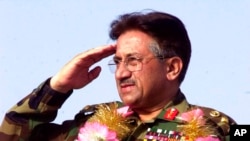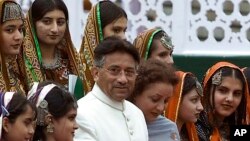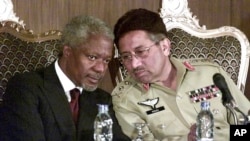Former Pakistan President Pervez Musharraf has died. He was 79.
He was suffering from amyloidosis, a rare disease in which an abnormal protein builds up in organs, causing them to malfunction.
Musharraf came to power in a bloodless coup on Oct. 12, 1999, deposing democratically elected Prime Minister Nawaz Sharif.
Promising to soon restore democracy, Musharraf went on to rule for almost nine years, holding the offices of president and chief of army staff simultaneously for most of that time.
Just months before the coup, while under Musharraf’s command, Pakistani troops had entered the Kargil sector of Indian-administered Kashmir. The action brought the nuclear-armed neighbors face to face on a battlefield located 5,000 meters above sea level. The roughly three-month-long Kargil War ended after Pakistan withdrew its troops under U.S. pressure and returned territory it had taken from India. India put the official death toll of the war at 527, while estimates of losses on the Pakistani side vary from a few hundred to a few thousand.
This soured relations between the military and Prime Minister Sharif, who in October 1999 hastily tried to replace Musharraf. However, the army refused to accept the new chain of command, took over the capital Islamabad, arrested Sharif and disbanded parliament, all within a matter of hours.
Pakistan’s fourth military dictator, Musharraf initially enjoyed popularity as he promised to crack down on corruption and increase accountability. His support grew as Pakistan’s economy flourished on the back of foreign assistance that the country received for supporting the U.S.-led coalition in Afghanistan.
Musharraf’s vision of “enlightened moderation” – promoting a moderate rather than fundamentalist interpretation of Islam -- was welcomed by many in Pakistan who were worried by events in Afghanistan -- the rise of the Taliban, al-Qaida’s presence and the U.S. war on terror.
His era saw the Pakistani media landscape change as the government licensed dozens of private media houses to run news and entertainment channels in a market that until then had been largely occupied by the state broadcaster, Pakistan Television Corporation (PTV).
However, as his rule dragged on, major political parties remained suppressed, thousands of political opponents were arrested, and the freedom of the media and judiciary was curbed. Musharraf eventually suspended the constitution in 2007 – an act for which he was tried for treason in 2013 and given capital punishment in absentia six years later. The punishment was struck down in 2020.
While still holding the office of the Chief of Army Staff, Musharraf ruled Pakistan as the Chief Executive from 1999-2001. His military-run government’s decision to support the U.S. in the Afghan war grew increasingly unpopular as Pakistan suffered a rise in militancy and terrorism from local groups that supported the Afghan Taliban.
Speaking to VOA years later, in 2010, Musharraf defended his decision, saying Pakistan would have suffered if it had not joined the U.S. lead coalition in Afghanistan.
“And this decision was in Pakistan’s interest, let me tell you. We did not do this for America. Does Pakistan need Taliban and Talibanization? Ask Pakistanis and I think everyone will say no. That’s why we had no need to support the Taliban and fight against the coalition in favor of the Taliban,” he said.
Washington and Kabul, however, often accused Pakistan of providing sanctuaries and support to the Afghan Taliban, a charge Pakistan officially denied.
In 2002 Musharraf held a referendum that solidified his position as the most powerful man in the country for the next five years. Voters were asked to say ‘yes’ to keeping him in the president and army chief’s roles until 2007, if they wanted Pakistan to stay on the path of economic reform and prosperity. Results of the referendum, disputed by political parties and civil society, showed 97% supported Musharraf.
But by 2007 Musharraf faced a plethora of problems.
His attempt to depose the Chief Justice of Pakistan Iftikhar Muhammad Chaudhry for alleged corruption led to a nationwide protest movement of lawyers that soon gained support from major political parties.
As political turmoil rose, Musharraf agreed to step down as army chief, but not before suspending the constitution and imposing a state of emergency in November 2007, citing “a threat to Pakistan’s sovereignty.” All political activity was banned, media were gagged, and senior members of the judiciary were detained.
By now, two of Pakistan’s most popular political leaders, Nawaz Sharif and Benazir Bhutto, who had spent most of Musharraf’s era in exile, were allowed to return under a controversial amnesty deal that ended corruption cases against them.
Bhutto’s assassination on Dec. 27, 2007, after a political rally in Rawalpindi, added to Musharraf’s woes. He was later accused of not giving the former prime minister adequate security, leading to her death. Musharraf denied the charges.
After his short-lived emergency, Pakistan held parliamentary elections in February 2008, which Bhutto’s party won. Facing impeachment, Musharraf resigned as president on Aug 18, 2008, and left Pakistan the next year.
His political ambitions, however, did not end. While shuttling between Dubai, the U.S. and U.K., he launched the All Pakistan Muslim League party and returned in 2013 to run in elections. Tepid public support and the Election Commission’s decision to disqualify him due to his past actions pushed him out of the field.
That same year a court ordered the former president and army chief’s arrest for detaining judges in 2007. However, the military stood by him, preventing him from going to jail.
After Musharraf’s archrival, three-time prime minister Nawaz Sharif, won the 2013 elections, the government started proceedings against Musharaff on charges of high treason for suspending the constitution almost six years ago.
In 2019, a special court convicted Musharraf and handed him the death penalty. The decision calling for him to be hanged in public was met with anger by the powerful military and opposed by many others in Pakistan for its harsh language.
Next year, the Lahore High Court threw out the treason case and the death penalty against Musharraf. But hounded by legal troubles, he had already left Pakistan for Dubai in 2016 on medical grounds.
Musharraf survived at least four assassination attempts from militants, three during his rule.
He is survived by a wife, son and daughter.










